Marvel Rivals Competitive Scene Explained: Ranks, Seasons & Rewards
Updated On: November 12, 2025 by Aaron Connolly
Marvel Rivals Competitive Mode Overview
Marvel Rivals’ competitive mode shakes up this third-person hero-shooter with a ranking system where every match actually matters. You’ll run into tougher restrictions, hero bans, and matchmaking that pits you against folks near your skill level—so, yeah, it’s a lot sweatier than casual play.
Unlocking Competitive Mode
You’ve got to hit Level 10 before you can jump into competitive matches. The game wants to make sure you’ve got the basics down first.
This level requirement makes sense. New players really need some time to figure out what their heroes do and how to play with a team. Otherwise, ranked matches just get miserable for everyone.
Once you unlock it, competitive mode sticks around for good. Dropping below Level 10 later doesn’t lock you out, even after season resets or account changes.
Quick win: While you’re grinding to Level 10, pick up 2-3 heroes from different roles. That way, when hero bans show up at higher ranks, you won’t be stuck.
Differences from Quick Play
Competitive matches use a multi-round format instead of just one-and-done. Every win or loss moves your rank points up or down, so each round feels a lot more tense.
Once you hit Diamond III and above, things get spicier. Both teams get to ban two heroes before the match starts, so you’ll need backup picks ready.
Team restrictions also get tighter as you climb:
- Bronze to Gold: Team up with anyone, no problem
- Gold I to Celestial I: Only play with people within three divisions
- Eternity and One Above All: Teammates must be within 200 rank points
Cross-platform play? That’s out for ranked. PC and console players get split up for fairness.
Core Gameplay Mechanics
Rank points track your journey through 23 divisions and nine ranks. Win, you get points. Lose, you lose points. Every 100 points, you move up.
If you go on a winning streak or snag MVP, you’ll pick up bonus points. The system rewards consistent, strong play—not just lucky wins.
Chrono Shields keep you from dropping a division after a loss, but they only work a few times and need time to recharge.
At the start of each new season, everyone drops six divisions. This keeps things fresh and gives everyone a shot at climbing again.
If you hit Eternity or One Above All, you’ll lose points if you don’t play for a week. You can’t just park your account at the top.
How the Marvel Rivals Ranking System Works
Marvel Rivals runs on a rank point (RP) system across 9 tiers and 23 ranks, all the way from Bronze III up to the rare One Above All. You gain or lose RP depending on wins, losses, and how well you play, with shields and decay in place to keep things fair.
Earning and Losing Rank Points
The RP system is pretty simple. You need 100 RP to go up a sub-tier (like Silver III to Silver II) and 300 RP to jump a whole tier (Gold III to Platinum III).
Win streaks really pay off. Four wins in a row? You get bonus RP, sometimes enough to skip whole sub-tiers. Staying consistent is way better than just random wins.
Your personal stats matter a lot in Season 2. Kills, time on the objective, and not dying all help. Even if your team loses, playing well can soften the blow.
| Action | RP Change |
|---|---|
| Sub-tier advance | +100 RP |
| Full tier jump | +300 RP |
| Win streak (4+) | Bonus RP |
| Strong performance | Extra RP gain |
Heads up: Your RP swings depend on both the match result and your own play. Try to survive and help with objectives, not just chase kills.
Role of Chrono Shield
Every time you get promoted, you earn a Chrono Shield. It blocks RP loss from your first defeat after ranking up.
If you win, the shield recharges, but higher ranks make you win more to refill it. Diamond and above? It’s tougher to keep that safety net.
Quick win: Use your Chrono Shield to test new heroes or wild strategies. If you lose, you won’t get punished for that first try.
The system pushes players to keep climbing instead of just camping at a new rank. Shields don’t last forever, but they give you a little breathing room.
Rank Decay and Demotions
Only the top two ranks have decay. If you’re in Eternity or One Above All and take a week off, you’ll lose RP and might drop to Celestial.
Below Eternity, you don’t have to worry about time-based decay. Your rank stays put, even if you take a break.
Season resets hit everyone. Each season, all players drop nine sub-tiers. If you’re Diamond II, you’ll start the next season at Gold II.
Most ranks have soft demotion protection, especially with Chrono Shields. This helps keep losing streaks from tanking your rank too fast.
Quick win: If you reach Eternity, play at least one ranked match a week. Maybe set a reminder so you don’t lose your spot.
Competitive Ranks and Tiers Explained
Marvel Rivals has a 9-tier ranking system with 23 divisions, starting at Bronze III and topping out at the exclusive One Above All for the top 500 players. You’ll need 100 RP to climb each sub-tier and 300 RP to jump to the next tier.
Bronze to Grandmaster Tiers
The main competitive ranks are Bronze, Silver, Gold, Platinum, Diamond, and Grandmaster. Each one splits into three divisions (III, II, I).
Bronze is where everyone starts. Over 30% of players hang out in Bronze III, so you’re not alone if you’re there. Silver and Gold are next, with about 20% and 16% of the player base.
Platinum is where things start getting sweaty. Only about 10% of players make it to Platinum. Here, people know the game and work together way better.
Diamond is for the diehards. Just 4% of players reach Diamond, and they usually main a few heroes and know all the team tricks.
Grandmaster is right below the top. Fewer than 2% of players get here. These folks often play in community tournaments and maybe even dream of going pro.
Celestial, Eternity, and One Above All
The highest ranks are for the best of the best. Celestial has three sub-tiers but only about 0.5% of players reach it.
Eternity is a single tier, no divisions. Only 0.04% of players make it. If you don’t play for a week, you’ll drop back to Celestial.
One Above All is the very top—just 500 players worldwide. The roster changes constantly as people fight to stay in. A lot of these players stream or play in official events.
The top 500 get special recognition and exclusive rewards. They have to keep playing to hold onto their spots, since others are always gunning for them.
Special Divisions and Progression
Marvel Rivals adds a few twists to how you climb. Win streaks can net you over 150 RP in low tiers, sometimes letting you skip sub-divisions.
The Chrono Shield kicks in after every promotion. Your first loss triggers it, so you don’t lose RP. In higher ranks, you need more wins to get it back.
At the start of each season, everyone drops nine sub-tiers. This keeps rank inflation in check and gives everyone a shot at a fresh climb.
Gold III is where the pick/ban phase starts up in Season 2. Teams can ban two heroes, so you’ll want to know more than just your main.
Seasonal Structure and Rank Resets
Marvel Rivals runs on seasons that shake up the competitive scene every few months. Each season, everyone drops nine divisions and gets a new shot at climbing.
How Seasons Work
Marvel Rivals splits the competitive year into a bunch of seasons. Each one lasts a few months, with big updates like Season 2 and smaller ones like Season 2.5 in between.
Season Structure:
- Full seasons (Season 1, Season 2, Season 3)
- Mid-season updates (Season 1.5, Season 2.5, Season 3.5)
- Map rotations and balance tweaks
- New rewards and cosmetics
Mid-season updates like 2.5 don’t reset ranks. They just add new content or rebalance things. You keep your rank but need to play 10 matches to earn fresh rewards.
Originally, the devs wanted to do mid-season rank resets. Players pushed back, so now only full seasons reset your rank.
Rank Resets Between Seasons
Every new season drops you nine sub-tiers. If you’re Diamond II, you’ll land at Platinum I. Celestial III? Now you’re Diamond II.
This system:
- Stops smurfs from stomping at season start
- Lets top players prove themselves with new meta changes
- Makes everyone compete for their spot again
- Gives players a fresh record
Reset Examples:
- Grandmaster III → Gold I
- Platinum I → Silver I
- Bronze III → Bronze III (you can’t go lower)
Everyone gets dropped, even the One Above All players. That means the first few weeks of a new season are wild as high-rank players race back up.
Advancing Each Season
After a reset, you climb just like before. It’s still 100 RP for a sub-tier and 300 for a full tier. Win streaks are your best friend if you want to get back fast.
Quick Recovery Tips:
- Shoot for win streaks of four or more
- Use your Chrono Shield smartly
- Solo queue to test your pure skill
- Play regularly if you’re in Eternity or above
Season 2 started rewarding individual performance more. High kills, playing the objective, and not dying help you earn RP, even with weaker teammates.
Season 3 will probably keep the same reset style. Mid-season updates like 3.5 won’t reset your rank but will bring new rewards.
Hero Bans and Competitive Match Rules

Hero bans let teams block certain characters before a match, adding a strategic layer that really changes the game. The rules get stricter the higher you climb, since players at the top know the meta inside and out.
When Are Hero Bans Enabled?
Hero bans unlock when you hit Level 15 and reach Gold III in competitive. Every player in the match needs to meet both requirements for bans to show up.
During bans, each team member votes for heroes to block. Teams can ban up to two heroes each in regular matches. This all happens before anyone picks their hero.
After voting, the game randomly chooses from the suggested bans. You might not always get your top choice, but at least everyone has a say.
Quick tip: Try banning heroes that mess with your team’s plan, not just the most annoying ones.
Limitations at Higher Ranks
Once you hit Diamond and above, the ban rules get a lot more complicated. The system tightens up as you move up the ranks.
In tournaments, they switch to a more advanced Ban & Lock system. Here, team captains make all the calls instead of a team vote. Captains can ban up to three heroes and lock in two heroes for their team.
The captain role follows a simple order:
- The team captain decides everything.
- If the captain isn’t around, the backup takes over.
- If both drop out, the system just picks someone at random.
Warning: At Diamond and higher, you really need to know your stuff. Bans fly by quickly and can totally change the flow of a match.
Impact on Team Strategies
Hero bans push teams to come up with backup plans instead of sticking to one style. Teams spend a lot of time practicing different hero combos just to handle whatever bans come their way.
Usually, teams ban the strongest heroes or those that enable tricky team comps. Sometimes, they’ll even ban heroes just because the enemy team is really good with them, even if they’re not top-tier picks.
You can often guess a team’s plan from their bans. If they ban out supports, maybe they’re going for an aggressive push. If they target tanks, they might want more mobility or flanking plays.
In practice: Teams now dig into opponents’ hero pools and set up counter-bans. There’s a whole mind game before the match even starts. It adds a layer of tactical depth that sets strong teams apart.
Maps and Playlists in the Competitive Scene
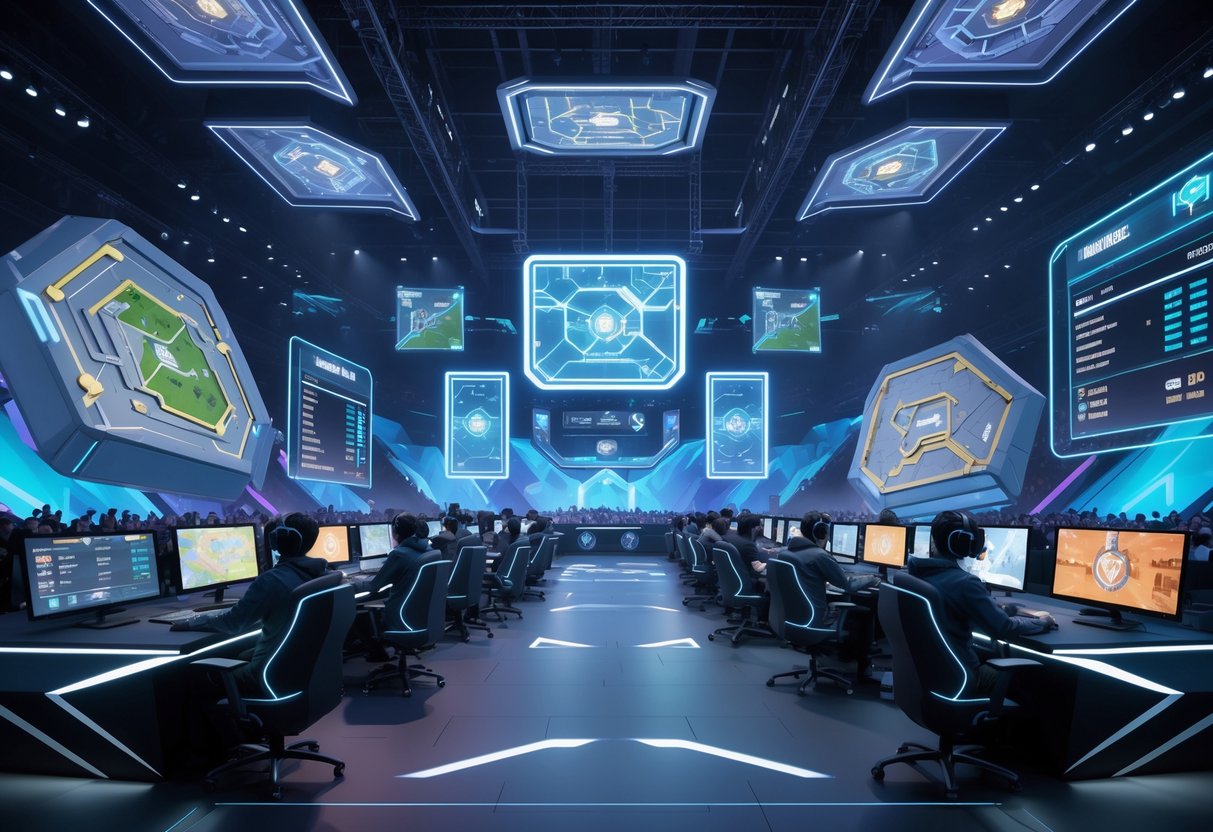
The competitive map pool includes 11 maps spread across seven unique environments. Seasonal rotations keep things interesting. Ranked matches use the same main game modes as quick play, but the maps favor teamwork and coordination.
Map Pool for Ranked Matches
Season 2 introduced 11 competitive maps set in different Marvel locations. Each map falls into one of seven biomes, which changes how teams need to play.
Right now, the rotation features crowd-pleasers like Hellfire Gala: Arakko and Empire of Eternal Night: Midtown. Some maps reward aggressive pushes, while others are better for defensive plays.
Hydra Charteris Base has tight hallways, making it great for close-range heroes. On the other hand, Krakoa is wide open and perfect for long-range damage dealers.
Usually, 8-10 maps are active in ranked at any given time. The rest get swapped in during seasonal updates, so teams always have something new to adapt to.
Quick tip: Don’t try to learn every map at once. Mastering just 3 or 4 maps—really knowing the sight lines and flanking spots—gives you a big advantage.
Differences in Convoy and Convergence
Convoy mode is all about escorting payloads through checkpoints. The maps tend to be pretty linear but still offer lots of flanking routes.
Attackers need to keep up the pressure, while defenders look for chances to pick off enemies or combo their ultimates.
Convergence mode is centered around capturing control points. You’ll see lots of team fights and abilities that control space.
The big difference? Convoy rewards teams that can keep pushing together, while Convergence is more about explosive fights and quick moves between points.
Both modes show up equally in ranked playlists. Knowing when to group up or split your focus can make or break your climb.
Rotating Seasonal Maps
Marvel Rivals drops 2-3 new maps each season and temporarily pulls others out of the rotation. This keeps things from getting stale.
Sometimes, maps like Emerald Flames take over for a season, then disappear for a while to get tweaks or updates.
The rotation system forces players to stay flexible. New seasonal maps often bring in fresh mechanics or hazards.
Warning: Don’t sleep on new maps just because you think they’ll be gone soon. If the community loves them, they might stick around for good.
Developers usually announce map changes a few weeks before the new season. This gives teams a little time to prep and adjust.
Understanding Rewards and Crests of Honour
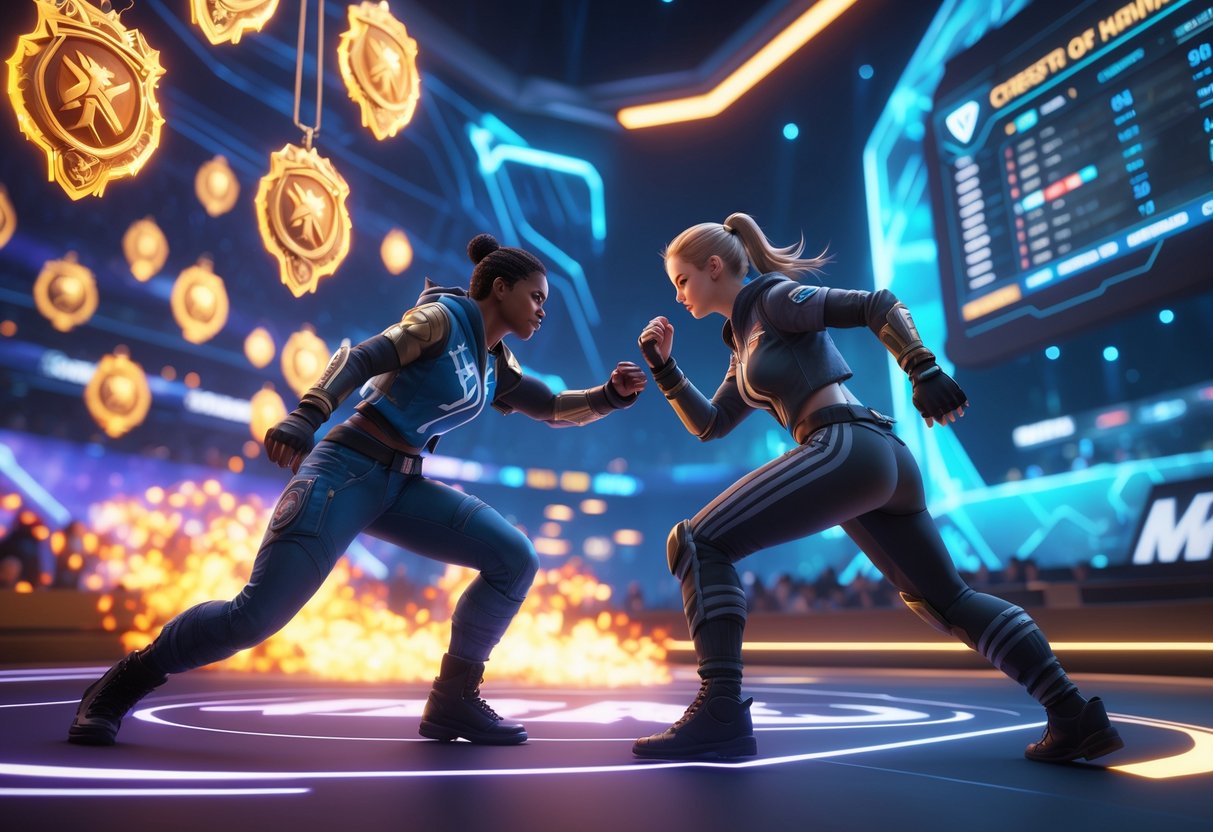
Marvel Rivals hands out exclusive cosmetics to competitive players based on their peak rank each season half. The main rewards are character skins and Crests of Honour that show off your achievements on your player nameplate.
Types of Competitive Rewards
You’ll find two main types of rewards for competitive play. The most obvious are character skins—like the Blood Shield Invisible Woman for hitting Gold Tier 3 or higher.
Crests of Honour are the other big reward. They pop up in the top right corner of your nameplate and let everyone see how far you made it last season.
The system tracks your highest rank each half-season. You only need to reach a rank once to get the reward—you don’t have to hold it until the end.
Every season brings new rewards. If you miss out, you can’t earn those cosmetics later.
Earning Crests of Honour
You get Crests of Honour by reaching specific competitive ranks during a season half. Higher ranks unlock fancier crest designs and colors.
The Silver Crest of Honour goes to players who reach Grandmaster Tier 3 or better. That includes both Grandmaster and Eternity ranks.
Climb higher, and you’ll unlock even flashier crests:
- Grandmaster Crest of Honour for Grandmaster ranks
- Celestial Crest of Honor for Celestial tier
- Eternity Crest of Honor for Eternity ranks
- Top 500 Crest of Honor for the best of the best
To equip a crest, just head to your player profile. Choose the CUSTOMISE tab, then NAMEPLATE. If you don’t have one active, it’ll say “No crest equipped” in the top right.
Seasonal Cosmetic Prizes
Every season half brings brand new cosmetic designs. In Season 1.5, they added four crest types instead of just two.
Lower ranks like Gold unlock character skins. From Grandmaster up, you start earning exclusive crests along with other goodies.
Warning: If you skip a season, you can’t get those cosmetics again. They don’t come back in later seasons.
Season 3 keeps the same system with fresh designs for each tier. It looks like this reward structure is here to stay as Marvel Rivals grows.
Climbing the Competitive Ladder Effectively
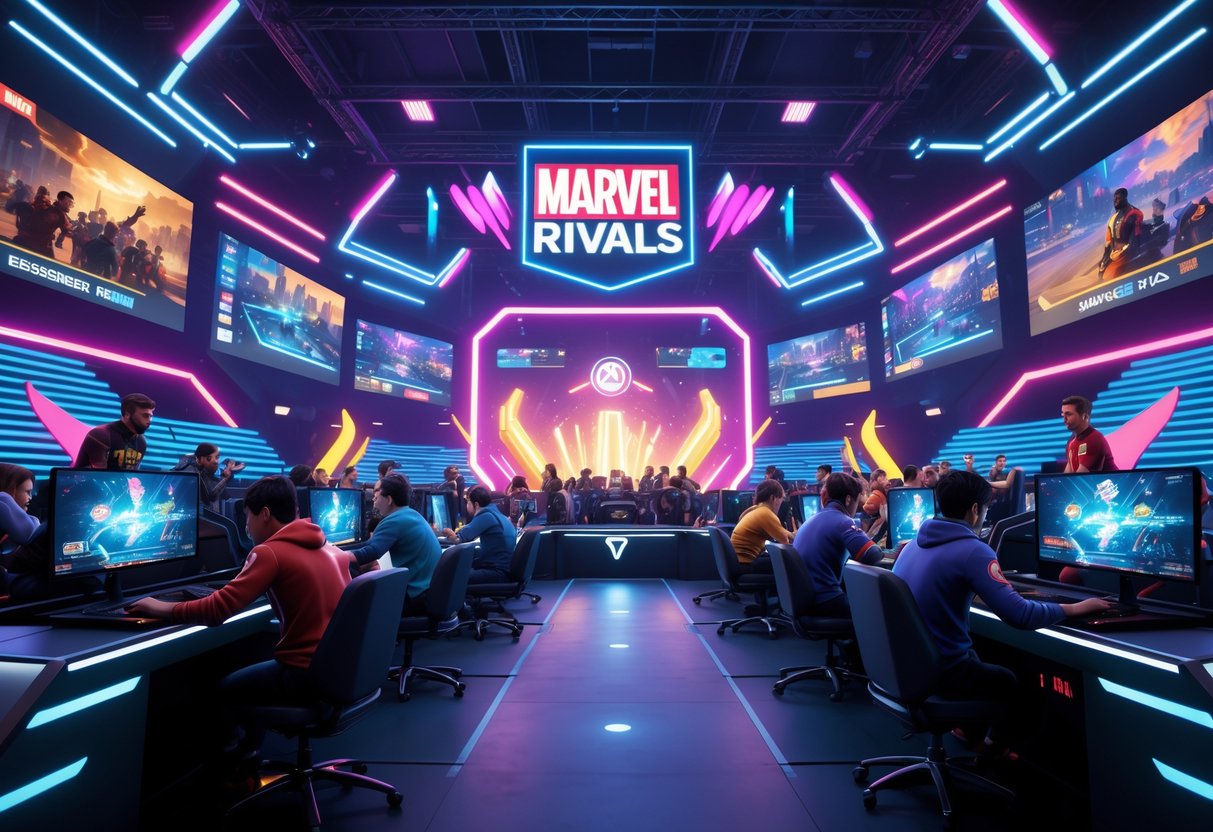
Climbing in Marvel Rivals competitive mode is all about maximizing your rank points, avoiding demotion, and knowing how team restrictions work. These strategies help you move up efficiently and dodge the common traps that keep people stuck.
Maximising Rank Point Gains
Winning streaks are your ticket to faster rank gains. Every win in a row gives you bonus points on top of the regular amount. So, keeping up your momentum matters more than just one good game.
MVP status gives you extra rank points. Focus on making big plays that actually help your team. Healing at the right time or clutching important eliminations usually beats just chasing damage numbers.
Play during peak hours for better matchmaking. More players online means more balanced matches. You’re less likely to get thrown against super high-ranked opponents who could break your streak.
Quick tip: Track your win rates at different times of day. Some folks have better luck when there are more casual players on in the evenings.
Wins at lower ranks usually give you 20-30 points. Higher divisions demand more points to move up, so building momentum early is a big deal.
Avoiding Rank Demotion Pitfalls
Chrono Shields protect you from dropping ranks. They kick in when you lose at zero points, but they recharge slowly and you only get a few each season.
Rank decay kicks in at the top levels. If you make it to Eternity or One Above All, you’ll lose points automatically if you don’t play often enough. This keeps the top ranks active.
Don’t jump straight back in after a bad loss. Taking a break helps you avoid tilt and losing streaks that can tank your rank. A clear head usually means better choices.
Watch for patterns that lead to demotion. Most people drop because of repeated mistakes, not just unlucky teammates. Go over your replays and look for things like bad positioning or missed abilities.
Warning: Every season reset drops everyone six divisions, no matter how high you climbed. Plan your sessions around resets if you want to collect all the rewards.
Playing with Friends in Ranked
Team restrictions get tighter at higher ranks. Bronze through Gold can group up freely. But from Gold I to Celestial I, you can only party with people within three divisions.
PC and console players can’t queue together in ranked. This keeps things fair with different controls and hardware.
The top ranks use point-based limits. Eternity and One Above All players can only team with Celestial II and I if the RP gap stays under 200.
So let’s say you’re Platinum II. You can queue with friends from Gold III up to Diamond III. That’s a decent amount of flexibility, but it keeps games competitive.
Good communication gives teams a real edge. Voice chat and coordination can beat out raw skill sometimes. But remember, your opponents probably have the same advantage at high ranks.
Quick win: Set a regular schedule to play with friends. Building team chemistry over time really pays off.
Special Features for Top Tier Players
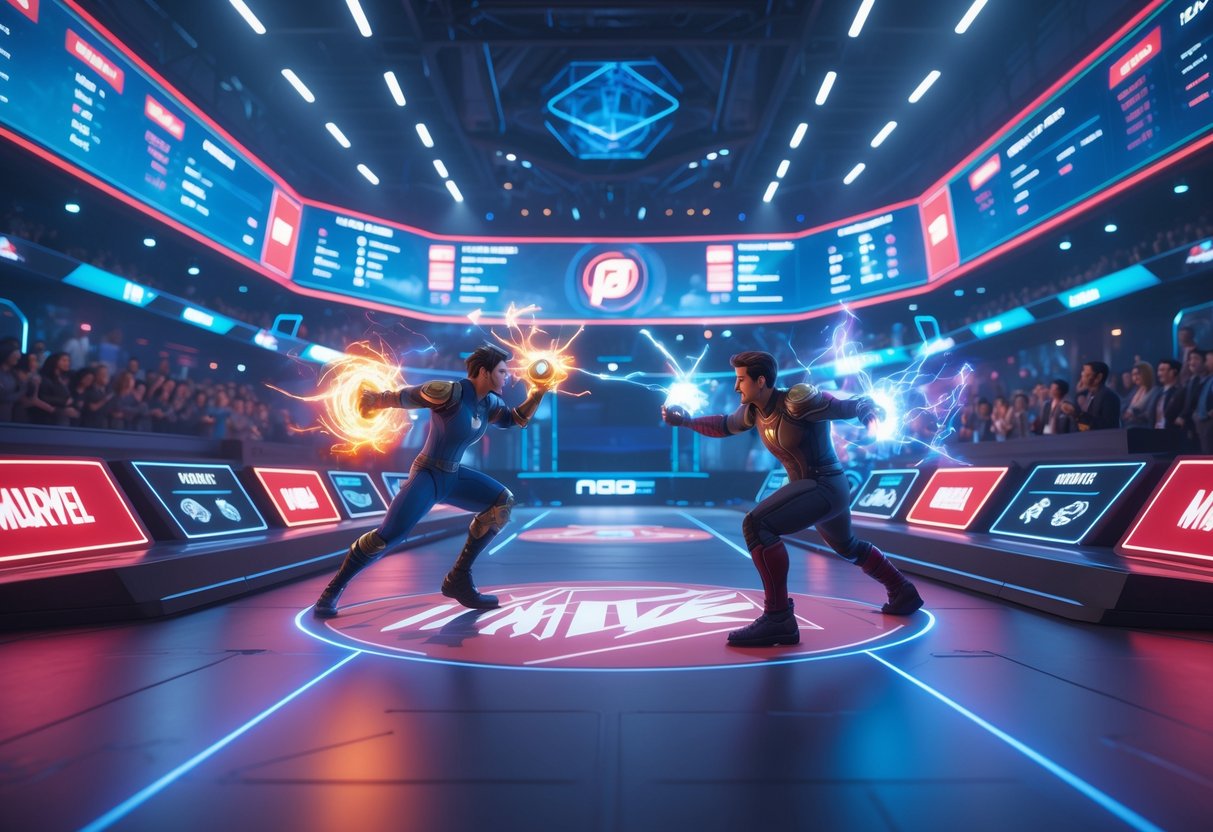
The highest Marvel Rivals ranks come with special perks and strict upkeep. Only the top 500 players worldwide earn One Above All, and Eternity players have to work to hold their spot.
One Above All and Top 500
One Above All is the absolute peak of Marvel Rivals. Only 500 players in the world get this rank.
There are no sub-divisions here. You’re either in the top 500, or you’re not.
The system ranks you by your Rank Points (RP) compared to other top players. To get in, you first have to reach Eternity, then rack up enough RP to break into the top 500.
Entry Requirements:
- Hit Eternity rank first
- Earn enough RP to be in the global top 500
- Play competitive matches every week
The competition is brutal. Every match counts when you’re fighting for one of just 500 spots.
Maintaining High Rank Status
Rank decay is a real threat at the top. Eternity and One Above All players lose RP if they go seven days without playing.
You have to play at least one ranked match a week. Miss it, and you’ll lose RP automatically.
If you decay, One Above All players can drop back to Celestial and lose that top 500 badge.
Weekly Requirements:
- Eternity: Play at least one ranked match every 7 days
- One Above All: Same deal, but with higher stakes
This decay system keeps the leaderboards active. Only players who actually play keep their spots.
Quick tip: Set weekly reminders so you don’t forget your ranked matches. Even one quick game can save your rank.
Unique Benefits at the Summit
Top-tier players get exclusive rewards each season.
Exclusive Rewards Include:
- Orange Top 500 Crest (One Above All only)
- Shared Top-Tier Crest (Eternity and One Above All)
- Animated profile borders with special effects
- Priority matchmaking with other top players
Matchmaking Restrictions:
- Celestial II: Can duo with Eternity/One Above All if within 200 RP
- Eternity & One Above All: Only solo or duo
- Partners have to be Celestial II+ and within 200 RP
These rules stop boosting and keep matches fair. High-rank players mostly face each other.
The visual rewards stay on your account forever. They show off your best achievement, even after a reset.
Warning: Every season reset knocks everyone down by nine sub-tiers. Even One Above All players have to start their climb all over again.
Competitive Scene Progression and Historical Highlights
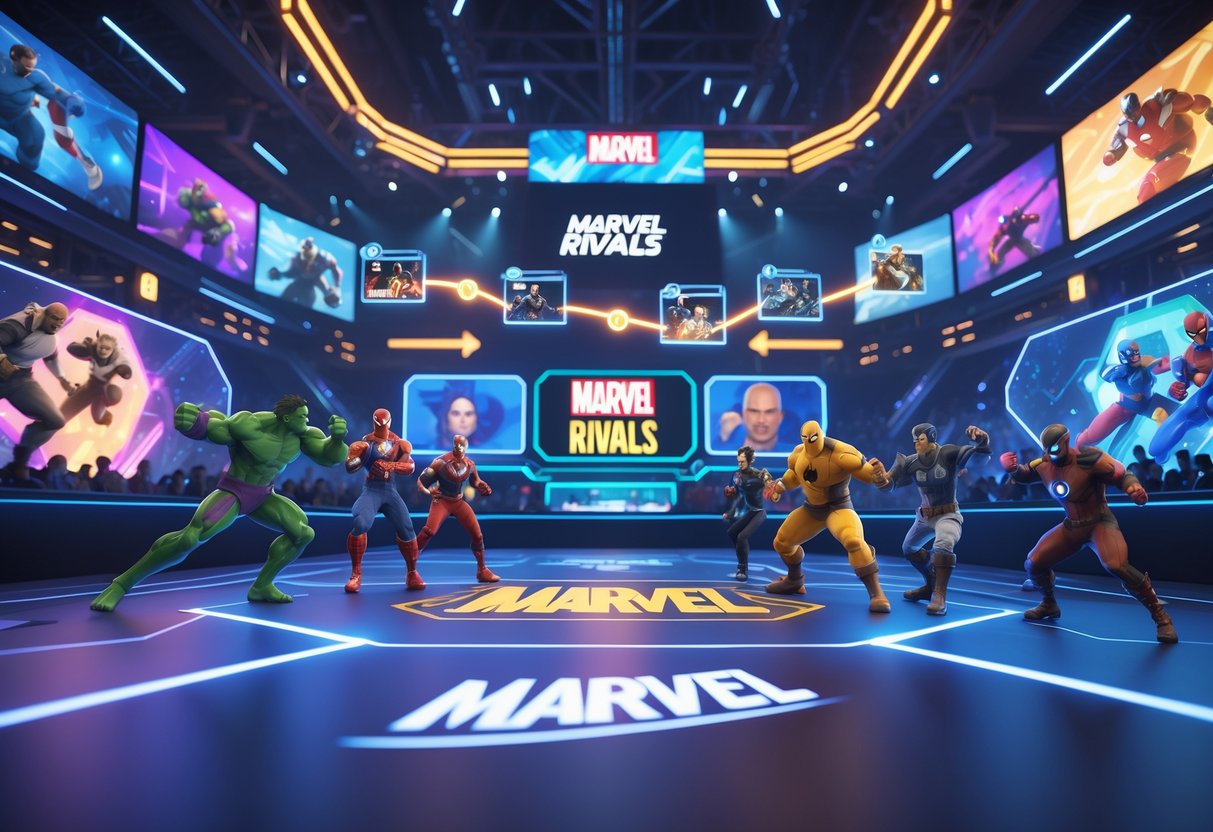
Marvel Rivals has changed a lot since launch. What started as a basic ranked system in Season 0 now feels like a much more complex and rewarding competitive scene.
Developers added features like hero bans, better rewards, and simpler progression paths. These changes really shaped how people approach ranked play.
Evolution of Ranked Modes
Season 0 kicked things off with a simple ranking system. Players had to hit Level 15 before even seeing ranked mode, which set the tone for who could join the competition.
The hero ban system really shook things up. Once you reach Gold III or higher, both teams can ban two heroes each. That move changed high-level matches by forcing teams to adjust strategies on the fly.
Key changes over time:
- Match timers dropped from 5 to 4 minutes.
- Checkpoint bonus time lowered from 180 to 150 seconds.
Developers brought in the timebank system to make overtime fairer. They also set up season resets, dropping everyone back by seven tiers each new season.
The ranks themselves grew from just a few in early seasons to a nine-rank ladder now. Below Eternity, every rank has three tiers, and you need 100 points to move up each tier.
Notable Past Seasons
Season 0 gave us the first taste of competitive play, with basic rewards like Golden Moonlight for Gold III and above. Not flashy, but it started the tradition of seasonal prizes.
Season 1.0 and 1.5 rolled in the Crest of Honour system. Players could earn Blood Shield and Blood Blaze cosmetics—finally, rewards that stood out.
Season 2.0 and 2.5 brought Golden Diamond rewards and made the whole system clearer. Players could finally track their progress without confusion.
Season 3.0 went all in on Phoenix-themed rewards. Phoenix Feathers and Phoenix Force cosmetics tied the season to Marvel lore, making the grind feel more meaningful.
Season 3.5 is where we are now. The Emerald and Symbiotic rewards look sharp, and the Top 500 get exclusive recognition. The reward tables are easier to follow than ever.
Introductory Ranks and Milestones
New players start their ranked journey at Level 15. Early placement matches decide your starting rank, and your individual performance matters more than you might expect.
Bronze to Gold is the learning curve. Players in these ranks work on teamwork and basic objectives, since hero bans aren’t a factor yet.
Gold III is a big step up. Here, you unlock hero bans and become eligible for seasonal rewards. You’ll need to finish at least 10 competitive matches to snag those cosmetics at season’s end.
Platinum and Diamond test your deeper game knowledge and consistency. Teams here actually coordinate, and hero picks start to matter a lot more.
Grandmaster through Celestial is where the top players live. These ranks demand both strong individual skill and tight team play. The rewards get much more exclusive, too.
Eternity and One Above All sit at the very top. Eternity doesn’t have tier divisions, and One Above All is just for the top 500 players worldwide.
The Chrono Shield system tries to protect you from dropping ranks too easily. It needs time to recharge at higher ranks, so you have to plan your games carefully.
Important Considerations and Restrictions in Ranked Play

Marvel Rivals competitive ranks come with a bunch of rules. These rules limit who you can team up with and aim to keep matches fair for everyone.
The game disables crossplay between PC and console players in ranked. Community standards also try to keep the environment positive.
Queue Restrictions by Rank
Every rank tier has its own rules for teaming up. This helps prevent boosting and keeps matches less lopsided.
Bronze to Gold II players can team up with anyone. No restrictions here.
Gold I to Celestial I players can only team up within three divisions of each other. So, a Gold I player could join up with someone from Silver II through Platinum II.
The highest ranks are the strictest:
| Rank Level | Queue Type | Party Rules |
|---|---|---|
| Celestial II | Duo only | Can play with Eternity/One Above All if RP gap ≤ 200 |
| Eternity & One Above All | Solo/Duo | Limited to Celestial II or Celestial I within 200 RP |
If you try to break these rules, the game just blocks your party from ranked. No sneaking through.
No PC-Console Crossplay in Ranked
Ranked mode cuts out crossplay completely. PC players only match with other PC players, and console users stay with consoles.
Honestly, it makes sense—mouse and keyboard give PC players better aim and reaction times. Controller players can’t really keep up in that department.
This restriction only applies to ranked. Casual modes still let everyone play together, regardless of platform.
Heads up: If you want to play ranked with friends on other platforms, you’ll all need to be on the same type.
Fair Play and Community Standards
Marvel Rivals uses automated systems to catch cheaters, boosters, and toxic players. If you break the rules, you might get anything from a short suspension to a permanent ban.
Boosting means high-skill players help others climb ranks unfairly. The system looks for weird RP gains and odd performances to spot this.
Griefing and toxicity trigger chat restrictions or even bans from competitive play. The system checks for bad chat behavior and intentional feeding.
You can report bad teammates or opponents right in-game. If enough people report someone, the moderation team will take a closer look.
Frequently Asked Questions
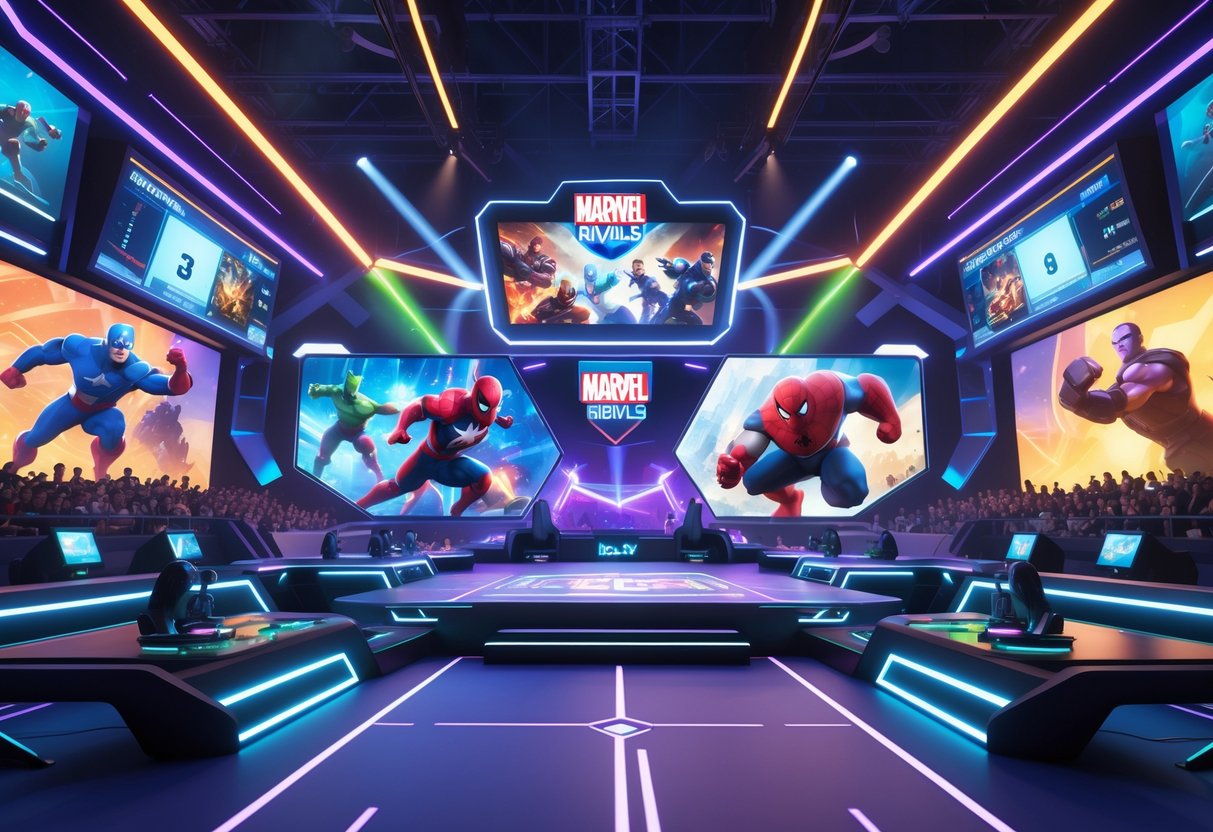
Players have a lot of questions about Marvel Rivals’ ranking and team systems. The game gives everyone a few different ways to track progress and see how far they’ve come.
How can players of different ranks team up in Marvel Rivals?
You can queue with friends of different ranks, but there are some limits. The system averages everyone’s competitive scores and tries to match you against a team with a similar average.
If your group has a big rank gap, matches can get weird. Some players might feel outmatched or just get steamrolled.
In Season 3.5, the game stopped letting four- and six-player teams queue at higher ranks. It just got too hard to find fair matches with mixed skill groups.
What is a list of ranks available in Marvel Rivals, and how do they work?
Marvel Rivals uses a tiered ranking system, kind of like other competitive games. Each rank means a different skill level and score range.
You’ll find Bronze, Silver, Gold, Platinum, Diamond, Vibranium, Celestial, Eternity, and One Above All. Winning matches moves you up, while losses can drop you down.
Your competitive score decides your rank. When you win, your score goes up; when you lose, it drops.
Performance matters too. The game compares your stats to others using the same hero at your rank.
Could you break down the rank distribution in Marvel Rivals for us?
Most players end up in the middle—Silver and Gold. That’s pretty standard for competitive games.
Bronze and Silver are full of newer players. The game weighs performance points more here, so skilled players can climb out faster.
Diamond and above are tough. Winning and losing counts for more than individual performance at these levels.
At the very top—Celestial, Eternity, and One Above All—you’ll only find a tiny slice of the player base. These are the best of the best.
Where can one track their progress and rank changes in Marvel Rivals?
You can see your current rank and score in the competitive menu. After each ranked match, the game shows your point changes right away.
It even breaks down how much came from base points and how much from performance. Your profile keeps a record of your seasonal progress and rank history.
Tip: Check your stats after every game to see what actually moved your rank.
What is the Celestial rank in Marvel Rivals, and how do you achieve it?
Celestial is one of the highest ranks in the game. Only a small group of players make it here each season.
To reach Celestial, you’ll need to win consistently at Diamond and Vibranium. You have to hit the competitive score threshold for Celestial.
At this level, base points matter a lot more—about 70%—while individual performance counts for 30%. Queue times get longer because there just aren’t many players at the top, and the game tries to keep matches fair.
Could you describe what the Eternity and One Above All ranks entail in Marvel Rivals?
Eternity and One Above All stand at the very top of Marvel Rivals’ competitive ladder. Only a handful of the most talented players in each region ever reach these ranks.
You really have to play at an elite level over many matches to get here. If you want to stay at the top, you’ve got to keep outperforming other top players—no breaks.
People in these ranks usually deal with crazy long queue times. The game just can’t always find opponents with similar skill, so it keeps widening the search.
A lot of players at this level stream their matches or compete in tournaments. Honestly, the skill gap between these ranks and even Celestial is bigger than most expect.

